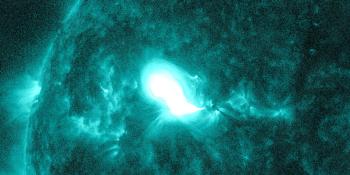Visualizzazione archivio di mercoledì, 27 luglio AM
Rapporto attività solare
Ogni brillamento solare menzionato nel rapporto ha un fattore di scala, applicato dal Centro di Predizione Meteorologica Spaziale (SWPC). A causa del fattore di scala del SWPC, i brillamenti solari sono segnalati come ridotti del 42%, rispetto ai dati di qualità scientifica. Il fattore di scala è stato rimosso dai nostri dati archiviati sui brillamenti solari, per riflettere le unità fisiche reali.
Rapporto dell'Attività Geofisica Solare 2011 Jul 27 2200 UTCPreparati dal SWPC della NOAA© ed elaborati da SpaceWeatherLive.com
Rapporto Congiunto USAF/NOAA dell'Attività Solare e Geofisica
SDF Numero 208 Emesso alle 2200Z il Jul 27 2011IA. Analisi delle Regioni Solari Attive e Attività dalle 2100Z-26 alle 2100Z-27 Solar activity was moderate. Region 1260 (N18E30)
produced a M1/1n flare at 1607Z as well as numerous C-class flares
during the past 24 hours. This region showed some magnetic
complexity (magnetic class beta-gamma) and changed steadily
throughout the day. Region 1261 (N15E60) is the largest group on the
disk (250 millionths) but is a simple magnetic beta group and only
produced one subflare during the day. New Region 1262 (N16W38) was
assigned and is a small D-type group with a weak delta configuration
in the trailing portion of the group. Despite its magnetic
complexity 1262 did not produce any flares. The eruption of a
filament from the northeast quadrant was observed at about 0620Z and
was associated with a faint, slow coronal mass ejection off the
northeast limb as observed by the LASCO C2 coronagraph beginning at
0642Z.
IB. Previsione dell'Attività Solare
Solar activity is expected to be
predominantly low but there is a chance for additional isolated
M-class flares from Region 1260.
IIA. Sommario dell'Attività Geofisica dalle 2100Z-26 alle 2100Z-27
The geomagnetic field was quiet. The greater than 2 MeV electron flux
at geosynchronous orbit reached high levels during the period.
IIB. Previsione dell'Attività Geofisica
The geomagnetic field is
expected to be quiet for the next three days (28-30 July). Recent
analysis from Stereo-B and solar imagery suggest that the previously
anticipated high speed stream from a coronal hole is most likely to
start affecting Earth on 31 July.
III. Probabilità dell'Evento dalle Jul del 28 alle Jul del 30
| Classe M | 40% | 40% | 40% |
| Classe X | 01% | 01% | 01% |
| Protone | 01% | 01% | 01% |
| PCAF | green | ||
IV. Flusso di 10.7 cm di Penticton
Osservato 27 Jul 099 Previsto 28 Jul-30 Jul 100/100/105 Media di 90 Giorni 27 Jul 095
V. Indici Geomagnetici A
Osservato Afr/Ap 26 Jul 005/005 Stimato Afr/Ap 27 Jul 005/005 Previsto Afr/Ap 28 Jul-30 Jul 005/005-005/005-005/005
VI. Probabilità dell'Attività Geomagnetica dal 28 Jul al 30 Jul
| A. Latitudini Medie | |||
|---|---|---|---|
| Attivo | 05% | 05% | 05% |
| Tempesta minore | 01% | 01% | 01% |
| Tempesta maggiore-grave | 01% | 01% | 01% |
| B. Latitudini Alte | |||
|---|---|---|---|
| Attivo | 05% | 05% | 05% |
| Tempesta minore | 01% | 01% | 01% |
| Tempesta maggiore-grave | 01% | 01% | 01% |
Tutti gli orari in UTC
<< Vai alla pagina della panoramica giornaliera
Ultime notizie
Ultimi messaggi dal forum
AR 13905 50Growth of Cycle 25 760AR13906 16Incoming & Unnumbered Active Regions 1259Coronal mass ejection impact and G4 geomagnetic storm 10 & 11 October 2024 929
Altri argomentiSupporta SpaceWeatherLive.com!
Molte persone vengono su SpaceWeatherLive per seguire l'attività del Sole o sapere se ci sia la possibilità di vedere l'aurora, ma a maggior traffico corrispondono costi maggiori. Considerate una donazione se vi piace SpaceWeatherLive così che possiamo mantenere online il sito web!

Notizie sul meteo spaziale
| Ultimo brillamento X | 2024/11/06 | X2.39 |
| Ultimo brillamento M | 2024/11/24 | M1.0 |
| Ultima tempesta geomagnetica | 2024/11/10 | Kp5+ (G1) |
| Giorni senza macchie | |
|---|---|
| Ultimo giorno senza macchie | 2022/06/08 |
| Media mensile Numero di Macchie Solari | |
|---|---|
| ottobre 2024 | 166.4 +25 |
| novembre 2024 | 144.7 -21.7 |
| Last 30 days | 158.7 +10.9 |


